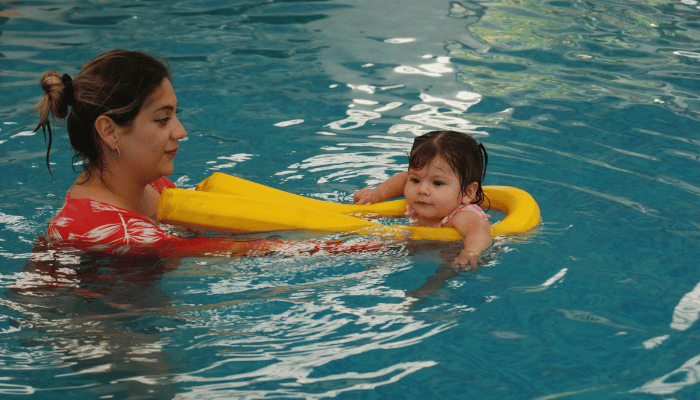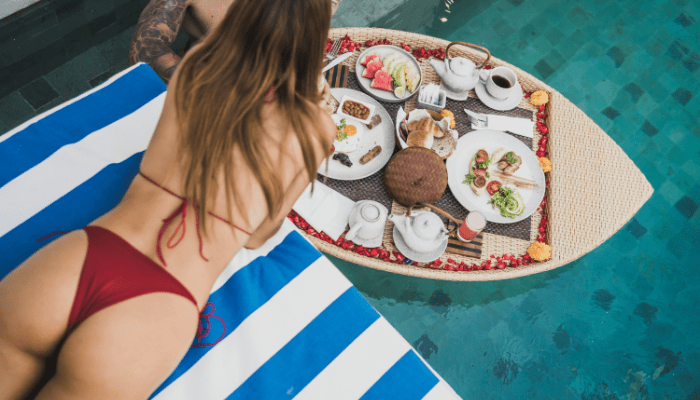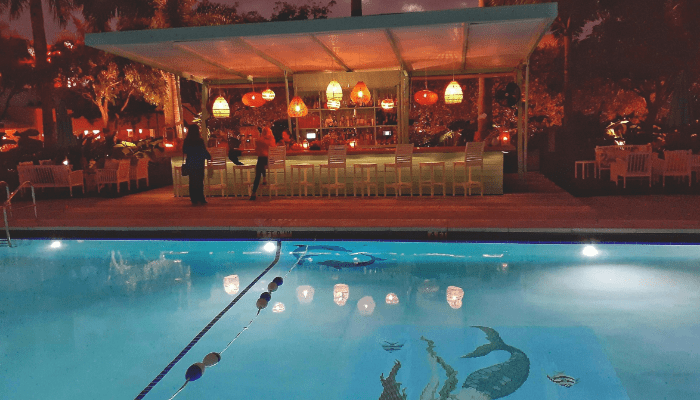Key Takeaways
- Babies under 6 months should stay out of pools due to temperature and health risks.
- Always supervise closely, drowning is fast and silent.
- Use only Coast Guard approved life jackets, never float toys.
- Secure home pools with fences, alarms, and self‑latching gates.
- Limit water time and watch for signs of chill or fatigue.
- Keep rescue gear nearby and know CPR.
- Swim classes help comfort but don’t replace supervision.
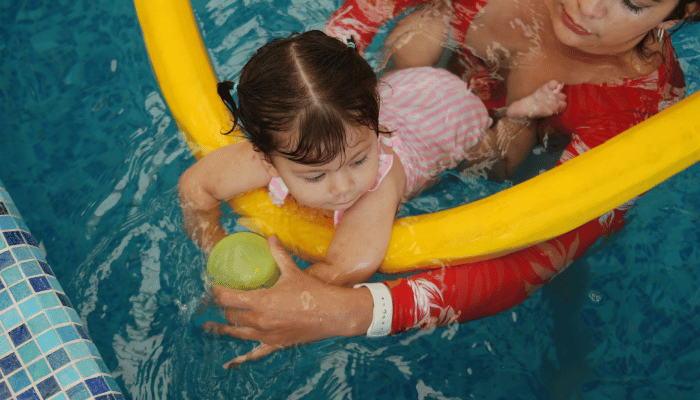
A child can drown in less than 30 seconds, and in as little as one inch of water. That’s not fear-mongering. That’s a fact.
Infant pool safety isn’t a parenting bonus point. It’s the baseline. Babies don’t splash for attention. They go under silently. No screaming, no flailing, no warning. That’s why it’s so critical that adults do all the heavy lifting on safety.
Let’s be honest: the idea of bringing a baby near water can feel a little terrifying. And weirdly adorable. Tiny swimsuits, floppy sun hats, floaties shaped like sea turtles, it’s cute overload and high-stakes parenting. So how do you balance it all?
You prepare. You don’t rely on luck or inflatable dolphins. You build confidence by knowing the risks and how to prevent them.
In this guide, we’re getting real about infant pool safety. No fluff. No fear tactics. Just smart, clear, parent-tested strategies to help your baby enjoy water safely, and help you relax a little while doing it.
Let’s get into it before that pool party invitation hits your inbox.
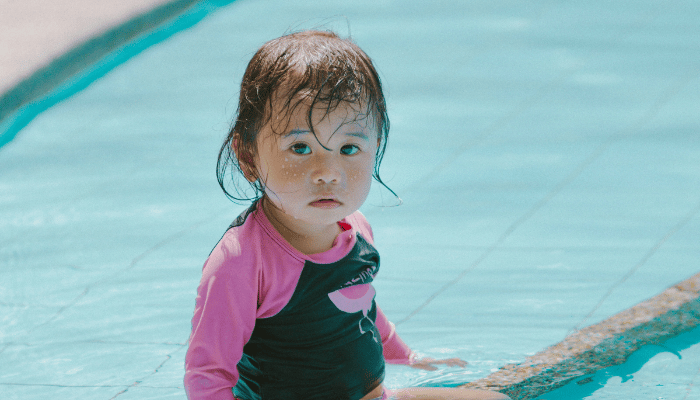
When Can a Baby Safely Go in a Pool?
Here’s the short version: wait until your baby is at least 6 months old.
Before that, babies can’t regulate body temperature well, their immune systems are still booting up, and public pools aren’t exactly gentle environments. Chlorine, germs, and unpredictable water temps? Not a great combo for a newborn.
Once your baby hits the 6-month mark, short pool sessions (10-15 minutes) in warm water, around 84-86°F (29-30 Celsius), are generally fine. Think of it as a brief intro, not a day-long soak. You’re aiming for happy splashes, not prune-fingered exhaustion.
Still unsure? Talk to your pediatrician. Especially if your little one has skin issues, allergies, or health concerns. Better safe than Googling at 2am.
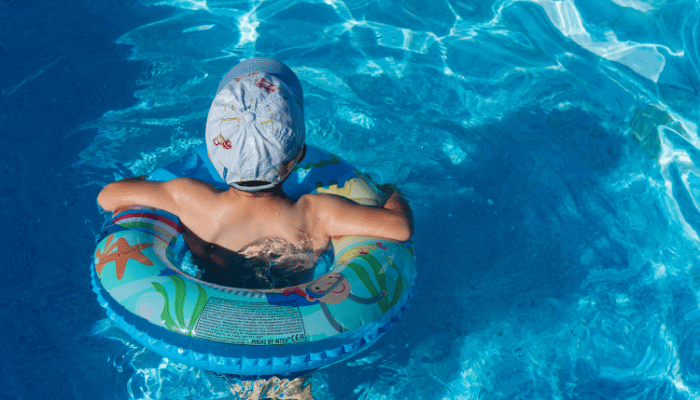
12 Infant Pool Safety Essentials Every Parent Should Know
1. Constant Supervision
One adult. One baby. One job.
If your baby is near or in the water, you need to be within arm’s reach, always. Don’t rely on older siblings, floaties, or “they’re just sitting in the shallow end.” Infants don’t give warnings. They just disappear under the surface.
Create a rule: if the baby’s in the water, someone is on full-time duty. No distractions. No switching roles without a verbal handoff. Treat it like passing the baton at the Olympics, because it kind of is.
2. Skip the Floaties
Here’s the deal: those adorable duck-shaped inflatables? They’re not safety gear. They’re toys. And they can flip faster than you can yell, “Grab the baby!”
If you want to use any floatation support, go with U.S. Coast Guard-approved infant life jackets. Yes, they’re bulky. Yes, your baby might hate it. But drowning is silent. Complaining is not. Let them fuss.
3. Install Proper Barriers & Alarms Around Pools
If you have a pool at home, this isn’t optional, it’s critical.
You want a 4-sided fence (not just a gate between the house and pool), self-latching gates, and bonus points for pool alarms that alert you when someone enters the water.
It’s like baby-proofing, but with higher stakes. Don’t just lock the front door, lock the water.
4. Avoid Pool Drains and Suction Hazards
Pool drains are like magnets for tiny hands, fingers, and anything loose. If you’re in a public or older pool, keep your baby far away from any suction points.
Long hair? Tie it up. Loose swim shirts? Tuck them in. Make it a habit now. Suction entrapment injuries are rare but devastating, and always preventable.
5. Limit Water Time & Watch for Hypothermia
Babies get cold fast. Even in warm water.
Stick to 10-20 minute sessions, depending on the water temp and your baby’s reactions. If they’re shivering, lips turning bluish, or suddenly cranky, get them out, wrap them up, and warm them gently.
Oh, and don’t use hot tubs. Not even for a minute. Babies don’t need spa days. They need functioning internal thermostats.
6. Use Swim Diapers
Not glamorous, but necessary. Swim diapers don’t hold pee. They’re built to catch the big stuff, and even that’s a stretch.
Change your baby before and after every swim session, and keep wipes, extra towels, and fresh clothes nearby. No one wants to be the parent whose kid shuts down the entire baby pool.
7. Keep Rescue Equipment Nearby
If you’re swimming at home, you need a ring buoy, a reaching pole, and a posted emergency contact sheet.
Even if you’re hyper-vigilant, accidents happen. And when they do, you don’t want to sprint across the yard looking for a phone.
8. No Distractions for Supervising Adults
This one’s simple. If you’re on watch, you’re on watch.
Put the phone away. Skip the book. Save the cocktail for after. If you’re supervising, act like a lifeguard, not a sunbather. You can rotate shifts with other adults, but multitasking isn’t an option here.
9. Learn Infant CPR and Basic First Aid
You hope you’ll never need it. But if you do, you’ll be beyond glad you took the time.
Look for pediatric CPR classes, many hospitals and community centers offer them. Even if you think you’ll remember from that one video, trust me: muscle memory matters when adrenaline spikes.
10. Avoid Floatation Dependency for Confidence
Don’t let floaties become your baby’s security blanket. They give a false sense of safety and make little ones think they can swim before they actually can.
Instead, hold your baby in the water. Let them feel their body move. Build familiarity, not false confidence.
11. Dry Off and Warm Up Immediately After Swimming
As soon as you get out of the water: dry, change, warm.
Especially on breezy days or in shaded areas.
Babies lose heat rapidly, and chlorine can irritate sensitive skin. A dry towel, fresh clothes, and a quick rinse go a long way.
12. Lead by Example: Model Safe Water Behavior
If you’re cannonballing, ignoring the gate, and treating safety rules like suggestions, guess what your kids will do later?
Even at 6 months, babies absorb patterns. They watch your every move. If you respect water, they’ll grow up learning how to do the same.
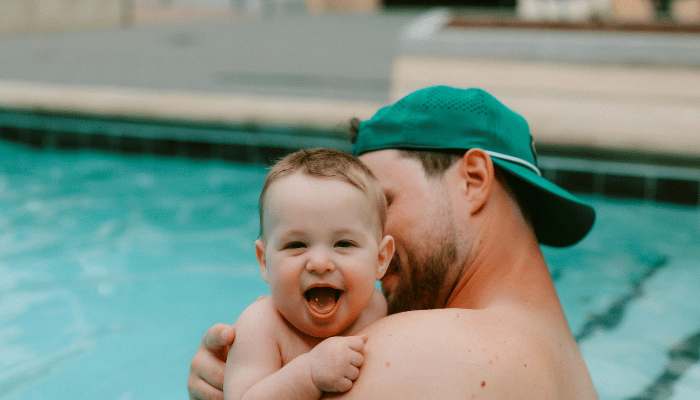
Best Pool Gear for Infant Safety
You don’t need a truckload of gear, but a few well-chosen essentials make a big difference.
- Swim diapers – snug fit, chlorine-safe
- Wide-brim sun hat – to protect delicate skin
- Rash guards – with UPF 50+ protection
- Infant life jackets – Coast Guard-approved only
- Baby water shoes – if pool surfaces are rough
- Towels x2 – one for drying, one for backup
- Non-slip mat – for the poolside changing area
You can skip the floaty unicorn. Unless you really want the photo. No judgment.
What About Infant Swim Classes?
They’re not magic, but they can help.
Parent-child swim classes can build water comfort, teach floating skills, and help you feel more confident holding your baby in the water. Just remember: they are not a substitute for supervision, nor do they “teach babies to swim” the way some TikToks claim.
Look for classes run by certified instructors with small student-to-teacher ratios. And always stay within arm’s reach, even in lessons.
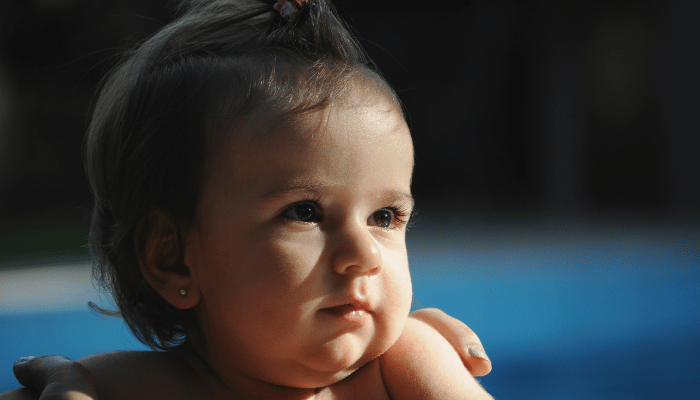
Common Myths About Infant Pool Safety
Myth: Babies are born knowing how to swim.
False. They have reflexes that look like swimming, but that’s not survival. It’s instinct, and it fades fast.
Myth: Floaties keep my baby safe.
Nope. They’re toys, not safety devices. Use approved gear only.
Myth: If they’re not crying, they’re comfortable.
Babies go silent when overwhelmed. Monitor their body temp and behavior, not just the volume.
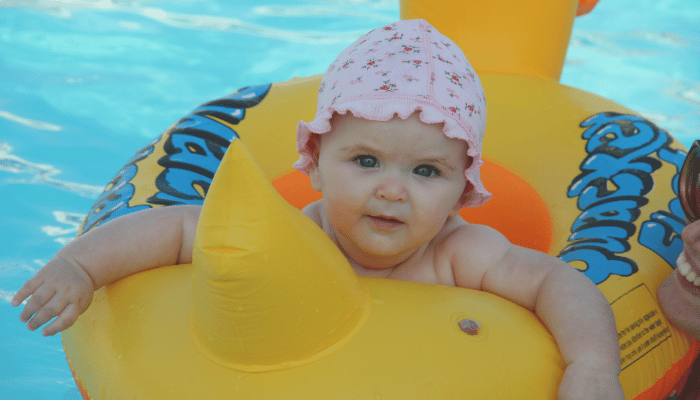
Printable Pool Safety Checklist for Parents
Keep it simple. Post this near the pool or pack it in your swim bag.
- Baby is at least 6 months old
- Water temp 84-86°F (29-30°C)
- Swim diaper changed recently
- Supervision within arm’s reach
- No floaties or unapproved gear
- Rescue equipment nearby
- CPR-certified adult present
- Baby dried and changed immediately after swim
- Sun protection in place
- Pool gate locked after use
Print it. Share it. Tape it to your cooler if you have to.
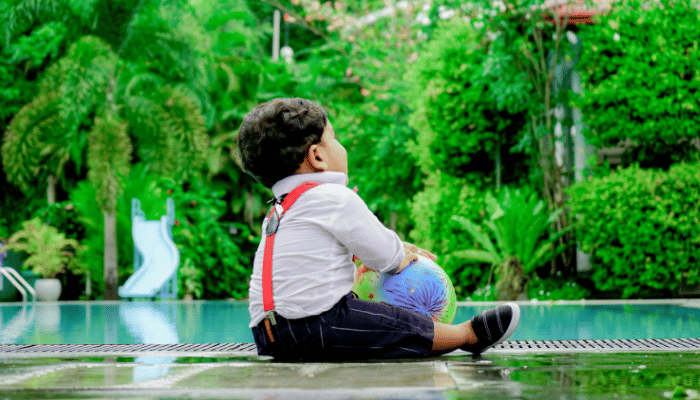
Conclusion
Water should be fun. It should also be safe. Those two things aren’t mutually exclusive, they just take planning.
Here’s what it comes down to: supervision trumps everything. Gear helps. Fencing is non-negotiable. CPR training is a no-brainer. But at the heart of it all? You. The alert, sunscreen-smudged adult standing poolside, scanning the surface like a hawk with a baby monitor in one hand and a towel in the other.
Will it be perfect? No. You’ll forget something. You’ll wonder if the diaper is leak-proof. You might even get splashed in the face before your first sip of iced tea. But with a solid safety plan, you’re giving your baby what they really need: protection, presence, and a safe way to explore something new.
Take the checklist. Bookmark the tips. Share them with your partner, your sitter, your neighbor with the pool. Safety gets easier when everyone’s on the same page.
You’ve got this. And that water? It’s waiting.
Pools should be designed for joy, and safety from day one.
At Oásis Biosistema, we build natural, family-friendly pools with thoughtful features for even your tiniest swimmers.
FAQ
Is a swimming pool safe for infants?
A swimming pool can be safe for infants if proper precautions are taken. Always supervise closely, use appropriate floatation devices, and keep the baby in shallow, warm water. Limit time in the pool, watch for signs of discomfort, and ensure the water is clean and properly treated.
When can a newborn baby go in a swimming pool?
Most experts recommend waiting until a baby is at least six months old before taking them into a swimming pool. Before this age, their immune system and ability to regulate body temperature are still developing. Always check water temperature, supervise constantly, and start with short sessions.
How to protect a baby from a pool?
To protect a baby near a pool, never leave them unsupervised, even for a moment. Use pool barriers or covers, keep floatation aids handy, and dress them in swim nappies and UV-protective clothing. Ensure the water is warm, clean, and chlorinated at safe levels to avoid irritation or illness.
Why can’t newborns go in the pool?
Newborns are not ready for pool water because their immune systems are immature and they can’t regulate body temperature well. Pool chemicals or bacteria may irritate their skin or cause infections. It’s best to wait several months before introducing them to swimming in a controlled, safe environment.

